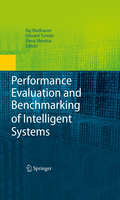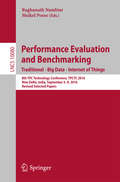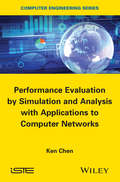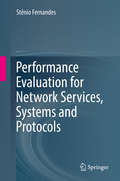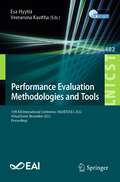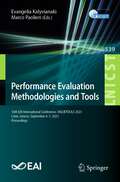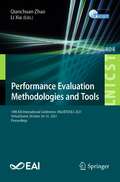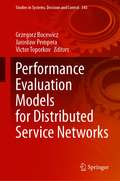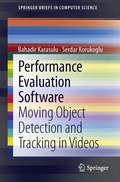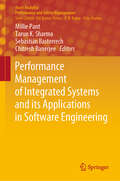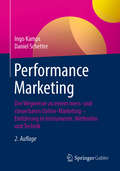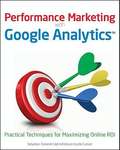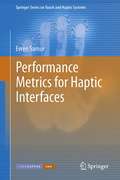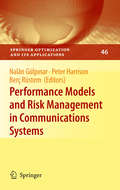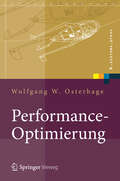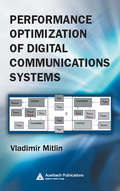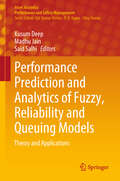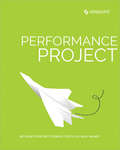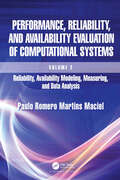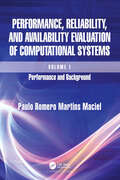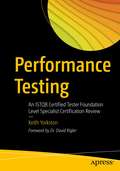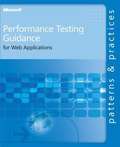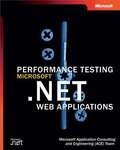- Table View
- List View
Performance Evaluation and Benchmarking of Intelligent Systems
by Raj Madhavan Elena Messina Edward TunstelThis contributed volume is dedicated to the subject of performance evaluation and benchmarking of intelligent systems by drawing from the experiences and insights of experts gained both through theoretical development and practical implementation of intelligent systems in a variety of application domains. The chapters cover a range of applications, such as assistive robotics, planetary surveying, urban search and rescue, and line tracking for automotive assembly. Subsystems include human-robot interaction, multi-robot coordination, communications, perception, and mapping, Chapters also cover simulation support and open source software for cognitive platforms, providing examples of enabling underlying technologies that can help intelligent systems to propagate and increase in capabilities. Performance Evaluation and Benchmarking of Intelligent Systems serves as a professional reference for researchers and practitioners in a variety of fields.
Performance Evaluation and Benchmarking. Traditional - Big Data - Internet of Things
by Raghunath Nambiar Meikel PoessThis book constitutes the thoroughly refereed post-conference proceedings of the 8th TPC Technology Conference, on Performance Evaluation and Benchmarking, TPCTC 2016, held in conjunction with the 41st International Conference on Very Large Databases (VLDB 2016) in New Delhi, India, in September 2016. The 9 papers presented were carefully reviewed and selected from 20 submissions. They reflect the rapid pace at which industry experts and researchers develop innovative techniques for evaluation, measurement and characterization of complex systems.
Performance Evaluation by Simulation and Analysis with Applications to Computer Networks
by Ken ChenThis book is devoted to the most used methodologies for performance evaluation: simulation using specialized software and mathematical modeling. An important part is dedicated to the simulation, particularly in its theoretical framework and the precautions to be taken in the implementation of the experimental procedure. These principles are illustrated by concrete examples achieved through operational simulation languages (OMNeT ++, OPNET). Presented under the complementary approach, the mathematical method is essential for the simulation. Both methodologies based largely on the theory of probability and statistics in general and particularly Markov processes, a reminder of the basic results is also available.
Performance Evaluation for Network Services, Systems and Protocols
by Stênio FernandesThis book provides a comprehensive view of the methods and approaches for performance evaluation of computer networks. It offers a clear and logical introduction to the topic, covering both fundamental concepts and practical aspects. It enables the reader to answer a series of questions regarding performance evaluation in modern computer networking scenarios, such as ‘What, where, and when to measure?’, ‘Which time scale is more appropriate for a particular measurement and analysis?’, 'Experimentation, simulation or emulation? Why?’, and ‘How do I best design a sound performance evaluation plan?’. The book includes concrete examples and applications in the important aspects of experimentation, simulation and emulation, and analytical modeling, with strong support from the scientific literature. It enables the identification of common shortcomings and highlights where students, researchers, and engineers should focus to conduct sound performance evaluation. This book is a useful guide to advanced undergraduates and graduate students, network engineers, and researchers who plan and design proper performance evaluation of computer networks and services. Previous knowledge of computer networks concepts, mechanisms, and protocols is assumed. Although the book provides a quick review on applied statistics in computer networking, familiarity with basic statistics is an asset. It is suitable for advanced courses on computer networking as well as for more specific courses as a secondary textbook.
Performance Evaluation Methodologies and Tools: 15th EAI International Conference, VALUETOOLS 2022, Virtual Event, November 2022, Proceedings (Lecture Notes of the Institute for Computer Sciences, Social Informatics and Telecommunications Engineering #482)
by Esa Hyytiä Veeraruna KavithaThis book constitutes the refereed conference proceedings of the 15th International Conference on Performance Evaluation Methodologies and Tools, VALUETOOLS 2022, held in November 2022. Due to the safety concerns and travel restrictions caused by COVID-19, VALUETOOLS 2022 took place online in a live stream. The conference provides a world-leading and multidisciplinary venue for researchers and practitioners in diverse disciplines such as computer science, networks and telecommunications, operations research, optimization, control theory and manufacturing. The 18 full papers were carefully reviewed and selected from 47 submissions and are grouped in thematically as following: game theory; queueing models; applications; retrial queues; performance analysis and networking; distributed computing.
Performance Evaluation Methodologies and Tools: 16th EAI International Conference, VALUETOOLS 2023, Crete, Greece, September 6–7, 2023, Proceedings (Lecture Notes of the Institute for Computer Sciences, Social Informatics and Telecommunications Engineering #539)
by Evangelia Kalyvianaki Marco PaolieriThis volume contains the proceedings of the 16th EAI International Conference on Performance Evaluation Methodologies and Tools, VALUETOOLS 2023, which took place in Heraklion, Crete during September 6-7, 2023. The conference brought together researchers, developers, and practitioners from around the world and from different communities including computer science, networks and telecommunications, operations research, optimization, control theory, and manufacturing. The 27 members of the International Program Committee (PC) helped to provide at least 3 reviews for each of the 30 submitted contributions. Based on the reviews and PC discussions, 11 high-quality papers (9 research papers, 1 tool paper, and 1 work-in-progress paper) were accepted to be presented during the conference. The volume includes contributions organized into four thematic sessions: Games and Optimization; Simulation; Networking and Queues; Tools.
Performance Evaluation Methodologies and Tools: 14th EAI International Conference, VALUETOOLS 2021, Virtual Event, October 30–31, 2021, Proceedings (Lecture Notes of the Institute for Computer Sciences, Social Informatics and Telecommunications Engineering #404)
by Qianchuan Zhao Li XiaThis book constitutes the refereed conference proceedings of the 14th International Conference on Performance Evaluation Methodologies and Tools, VALUETOOLS 2021, held in October 2021. Due to the safety concerns and travel restrictions caused by COVID-19, VALUETOOLS took place online in a live stream. VALUETOOLS 2021 aims to provide a world-leading and multidisciplinary venue for researchers and practitioners in diverse disciplines such as computer science, networks and telecommunications, operations research, optimization, control theory and manufacturing. The 16 full papers were carefully reviewed and selected from 32 submissions and focus on methodologies and practices in modelling, performance evaluation and optimization of complex systems.
Performance Evaluation Models for Distributed Service Networks (Studies in Systems, Decision and Control #343)
by Grzegorz Bocewicz Jarosław Pempera Victor ToporkovThis book presents novel approaches to formulate, analyze, and solve problems in the area of distributed service networks, notably based on AI-related methods (parallel/cloud computing, declarative modeling, fuzzy methods). Distributed service networks are an important area of research and applications. The methods presented are meant to integrate both emerging and existing concepts and approaches for different types of production flows through synchronizations. An integration of logistics services (e.g., supply chains and projects portfolios), public and multimodal transport, traffic flow congestion management in ad hoc networks, design of high-performance cloud data centers, and milk-run distribution networks are shown as illustrations for the methods proposed. The book is of interest to researchers and practitioners in computer science, operations management, production control, and related fields.
Performance Evaluation Software
by Serdar Korukoglu Bahadir KarasuluPerformance Evaluation Software: Moving Object Detection and Tracking in Videos introduces a software approach for the real-time evaluation and performance comparison of the methods specializing in moving object detection and/or tracking (D&T) in video processing. Digital video content analysis is an important item for multimedia content-based indexing (MCBI), content-based video retrieval (CBVR) and visual surveillance systems. There are some frequently-used generic algorithms for video object D&T in the literature, such as Background Subtraction (BS), Continuously Adaptive Mean-shift (CMS), Optical Flow (OF), etc. An important problem for performance evaluation is the absence of any stable and flexible software for comparison of different algorithms. In this frame, we have designed and implemented the software for comparing and evaluating the well-known video object D&T algorithms on the same platform. This software is able to compare them with the same metrics in real-time and on the same platform. It also works as an automatic and/or semi-automatic test environment in real-time, which uses the image and video processing essentials, e.g. morphological operations and filters, and ground-truth (GT) XML data files, charting/plotting capabilities, etc. Along with the comprehensive literature survey of the abovementioned video object D&T algorithms, this book also covers the technical details of our performance benchmark software as well as a case study on people D&T for the functionality of the software.
Performance Management of Integrated Systems and its Applications in Software Engineering (Asset Analytics)
by Millie Pant Tarun K. Sharma Sebastián Basterrech Chitresh BanerjeeThis book presents a key solution for current and future technological issues, adopting an integrated system approach with a combination of software engineering applications. Focusing on how software dominates and influences the performance, reliability, maintainability and availability of complex integrated systems, it proposes a comprehensive method of improving the entire process. The book provides numerous qualitative and quantitative analyses and examples of varied systems to help readers understand and interpret the derived results and outcomes. In addition, it examines and reviews foundational work associated with decision and control systems for information systems, to inspire researchers and industry professionals to develop new and integrated foundations, theories, principles, and tools for information systems. It also offers guidance and suggests best practices for the research community and practitioners alike.The book’s twenty-two chapters examine and address current and future research topics in areas like vulnerability analysis, secured software requirements analysis, progressive models for planning and enhancing system efficiency, cloud computing, healthcare management, and integrating data-information-knowledge in decision-making. As such it enables organizations to adopt integrated approaches to system and software engineering, helping them implement technological advances and drive performance. This in turn provides actionable insights on each and every technical and managerial level so that timely action-based decisions can be taken to maintain a competitive edge. Featuring conceptual work and best practices in integrated systems and software engineering applications, this book is also a valuable resource for all researchers, graduate and undergraduate students, and management professionals with an interest in the fields of e-commerce, cloud computing, software engineering, software & system security and analysis, data-information-knowledge systems and integrated systems.
Performance Marketing: Der Wegweiser zu einem mess- und steuerbaren Online-Marketing – Einführung in Instrumente, Methoden und Technik
by Ingo Kamps Daniel SchetterAus dem Inhalt:Teil I - Einführung: Meilensteine in der Entwicklung des Performance-MarketingTeil II - Performance-Marketing-Kanäle: Suchmaschinen-Optimierung.- Suchmaschinen-Werbung (SEA).- E-Mail-Marketing.- Display Advertising.- Affiliate-Marketing.- Social-Media-Advertising.- Influencer Marketing.- Teil III - Auswertung & Analyse: Web-Analyse (Web-Analytics).- TV-Tracking.- Teil IV – Spezialfälle: Mobile Marketing.- Amazon-Optimierung.- Preissuchmaschinen .- Teil V – Technologie: Data-Management-Plattform (DMP).- Adblocker.- Teil VI - Tipps & Tricks: Google AdWords vs. Facebook Ads.- In-House vs. Agenturen.- Betrug im Performance-Marketing.- Teil VII – Ausblick: Zukunft des Performance-MarketingsDieses Buch beschreibt leicht verständlich, welche Instrumente das Performance-Marketing bietet, wie sie erfolgreich eingesetzt und kontinuierlich optimiert werden können. Das Ergebnis ist ein vollständiger und praxisnaher Ratgeber für den erfolgreichen Start ins Performance-Marketing.Noch nie standen so viele Tools und Daten zur Verfügung, um dem Erfolg der eigenen Werbung auf die Spur zu kommen, Streuverluste zu vermeiden und passende Neukunden zu finden. Doch diese Vielzahl der Online-Marketing-Tools ist nicht nur ein Segen, neue Technologien bergen auch Risiken. Die Autoren bieten konkrete Hilfe: Sie schaffen einen Überblick über die wichtigsten Performance-Marketing-Instrumente und zeigen, worauf es beim Einsatz ankommt – bis hin zur Erkennung und Vermeidung von Betrugsversuchen.Die zweite Auflage ist vollständig überarbeitet mit Updates u.a. zum Datenschutz, Künstliche Intelligenz und technischen Neuerungen bei Google, Amazon & Co sowie neuen Kanälen wie z.B. Tik Tok.Gastbeiträge von und Interviews mit: Felix Beilharz (felixbeilharz.de)Marco Brenn (InBiz Online Marketing GmbH & Co. KG)Melina Hoischen (Kalilopii.de)Mario Jung (OMT.de)Markus Kellermann (xpose360)André Koegler (easy Marketing GmbH)Thore Ladicke (Facebook)Paul Niemeyer (Resolution Media)Marcus Pentzek (Searchmetrics)Martin Pichler (gutefrage.net GmbH)Christian Schmidt (Axel Springer Teaser Ad GmbH)Martin Sinner (Gründer idealo.de)Alexandra Streufert (Facebook) Professor Dr. Christian Stummeyer (Technische Hochschule Ingolstadt)Marcus Tandler (Ryte GmbH)Philipp Westermeyer (Online Marketing Rockstars)Markus Wigbels (easy Marketing GmbH)
Performance Marketing with Google Analytics
by Justin Cutroni Sebastian Tonkin Caleb WhitmoreAn unparalleled author trio shares valuable advice for using Google Analytics to achieve your business goalsGoogle Analytics is a free tool used by millions of Web site owners across the globe to track how visitors interact with their Web sites, where they arrive from, and which visitors drive the most revenue and sales leads. This book offers clear explanations of practical applications drawn from the real world.The author trio of Google Analytics veterans starts with a broad explanation of performance marketing and gets progressively more specific, closing with step-by-step analysis and applications.Features in-depth examples and case studies on how to increase revenue from search advertising, optimize an existing website, prioritize channels and campaigns, access brand health and moreDiscusses how to communicate with a webmaster or developer to assist with installationAddresses Google's conversion-oriented tools, including AdWords and AdSense, Google trends, Webmaster tools, search-based keyword tools, and moreTouches on brand tracking studies, usability research, competitive analysis, and statistical toolsThroughout the book, the main emphasis is demonstrating how you can best use Google Analytics to achieve your business objectives.Foreword by Avinash KaushikNote: CD-ROM/DVD and other supplementary materials are not included as part of eBook file.
Performance Metrics for Haptic Interfaces
by Evren SamurHaptics technology is being used more and more in different applications, such as in computer games for increased immersion, in surgical simulators to create a realistic environment for training of surgeons, in surgical robotics due to safety issues and in mobile phones to provide feedback from user action. The existence of these applications highlights a clear need to understand performance metrics for haptic interfaces and their implications on device design, use and application. Performance Metrics for Haptic Interfaces aims at meeting this need by establishing standard practices for the evaluation of haptic interfaces and by identifying significant performance metrics. Towards this end, a combined physical and psychophysical experimental methodology is presented. Firstly, existing physical performance measures and device characterization techniques are investigated and described in an illustrative way. Secondly, a wide range of human psychophysical experiments are reviewed and the appropriate ones are applied to haptic interactions. The psychophysical experiments are unified as a systematic and complete evaluation method for haptic interfaces. Finally, synthesis of both evaluation methods is discussed. The metrics provided in this state-of-the-art volume will guide readers in evaluating the performance of any haptic interface. The generic methodology will enable researchers to experimentally assess the suitability of a haptic interface for a specific purpose, to characterize and compare devices quantitatively and to identify possible improvement strategies in the design of a system.
Performance Modeling and Design of Computer Systems
by Mor Harchol-BalterComputer systems design is full of conundrums: •Given a choice between a single machine with speed s, or n machines each with speed s/n, which should we choose? •If both the arrival rate and service rate double, will the mean response time stay the same? •Should systems really aim to balance load, or is this a convenient myth? •If a scheduling policy favors one set of jobs, does it necessarily hurt some other jobs, or are these "conservation laws" being misinterpreted? •Do greedy, shortest-delay, routing strategies make sense in a server farm, or is what's good for the individual disastrous for the system as a whole? •How do high job size variability and heavy-tailed workloads affect the choice of a scheduling policy? •How should one trade off energy and delay in designing a computer system? •If 12 servers are needed to meet delay guarantees when the arrival rate is 9 jobs/sec, will we need 12,000 servers when the arrival rate is 9,000 jobs/sec?Tackling the questions that systems designers care about, this book brings queueing theory decisively back to computer science. The book is written with computer scientists and engineers in mind and is full of examples from computer systems, as well as manufacturing and operations research. Fun and readable, the book is highly approachable, even for undergraduates, while still being thoroughly rigorous and also covering a much wider span of topics than many queueing books. Readers benefit from a lively mix of motivation and intuition, with illustrations, examples, and more than 300 exercises - all while acquiring the skills needed to model, analyze, and design large-scale systems with good performance and low cost. The exercises are an important feature, teaching research-level counterintuitive lessons in the design of computer systems. The goal is to train readers not only to customize existing analyses but also to invent their own.
Performance Models and Risk Management in Communications Systems
by Berc Rustem Nalân Gülpınar Peter G. HarrisonThis volume covers recent developments in the design, operation, and management of mobile telecommunication and computer systems. Uncertainty regarding loading and system parameters leads to challenging optimization and robustness issues. Stochastic modeling combined with optimization theory ensures the optimum end-to-end performance of telecommunication or computer network systems. In view of the diverse design options possible, supporting models have many adjustable parameters and choosing the best set for a particular performance objective is delicate and time-consuming. An optimization based approach determines the optimal possible allocation for these parameters. Researchers and graduate students working at the interface of telecommunications and operations research will benefit from this book. Due to the practical approach, this book will also serve as a reference tool for scientists and engineers in telecommunication and computer networks who depend upon optimization.
Performance-Optimierung
by Wolfgang W. OsterhageComputer-Hardware ist heute zwar erschwinglich, dennoch spielt Performance nach wie vor eine wichtige Rolle - auch wegen der Beanspruchung großer Ressourcen bei komplexen Anwendungen. In dem Band werden drei Ebenen unterschieden (Systeme, Anwendungen und Geschäftsprozesse), auf denen sich Optimierungen erzielen und Kostenpotenziale erschließen lassen. Entsprechende Theorien, Messmethoden sowie Lösungsvorschläge zur Umsetzung von Optimierungsmaßnahmen auf der jeweiligen Ebene werden erläutert. Mit Checklisten für Messungen und Optimierungsmaßnahmen.
Performance Optimization of Digital Communications Systems
by Vladimir MitlinBecause fine-tuning the parameters of a system is critical to a developer's success, Performance Optimization of Digital Communications Systems examines particular optimization problems in digital communications, presenting analytical techniques in combination with SystemView and MATLAB simulations.
Performance Prediction and Analytics of Fuzzy, Reliability and Queuing Models: Theory and Applications (Asset Analytics)
by Kusum Deep Madhu Jain Said SalhiThis book presents the latest developments and breakthroughs in fuzzy theory and performance prediction of queuing and reliability models by using the stochastic modeling and optimization theory. The main focus is on analytics that use fuzzy logic, queuing and reliability theory for the performance prediction and optimal design of real-time engineering systems including call centers, telecommunication, manufacturing, service organizations, etc. For the day-to-day as well as industrial queuing situations and reliability prediction of machining parts embedded in computer, communication and manufacturing systems, the book assesses various measures of performance and effectiveness that can provide valuable insights and help arrive at the best decisions with regard to service and engineering systems. In twenty chapters, the book presents both theoretical developments and applications of the fuzzy logic, reliability and queuing models in a diverse range of scenarios. The topics discussed will be of interest to researchers, educators and undergraduate students in the fields of Engineering, Business Management, and the Mathematical Sciences.
Performance Project
by Bruno Skvorc Zoran Antolovic Claudio Ribeiro Tonino JankovPerformance simply matters. Technology may allow us to "go bigger", but maybe not necessarily be better when it comes to performance. Now is the time to utilize the amazing tools that are available for making websites faster, and to learn how to improve user experience and satisfaction. This book contains a series of practical, real-world performance tutorials, all based around a single project: a simple image gallery blog. We'll build the project, and then run through a series of performance optimization processes; by the time we're done, we'll have achieved very significant performance improvements. This book is packed with useful, real world hints and tips that you can use on your sites today. It contains: Building an Image Gallery Blog with Symfony Flex: the Setup by Zoran AntolovicBuilding an Image Gallery Blog with Symfony Flex: Data Testing by Zoran AntolovicPHP-level Performance Optimization with Blackfire by Bruno SkvorcMySQL Performance Boosting with Indexes and Explain by Claudio RibeiroImproving Performance Perception with Pingdom and GTmetrix by Tonino JankovImproving Performance Perception: On-demand Image Resizing by Bruno SkvorcUsing Background Processing to Speed Up Page Load Times by Bruno SkvorcServer-side Optimization with Nginx and pm-static by Tonino JankovHow to Use Varnish and Cloudflare for Maximum Caching by Bruno Skvorc This book is for all developers who wish to build sites and apps that run faster. It covers a range of performace tools; familiarity with web development is assumed.
Performance, Reliability, and Availability Evaluation of Computational Systems, Volume 2: Reliability, Availability Modeling, Measuring, and Data Analysis
by Paulo Romero MacielThis textbook intends to be a comprehensive and substantially self-contained two-volume book covering performance, reliability, and availability evaluation subjects. The volumes focus on computing systems, although the methods may also be applied to other systems. The first volume covers Chapter 1 to Chapter 14, whose subtitle is ``Performance Modeling and Background". The second volume encompasses Chapter 15 to Chapter 25 and has the subtitle ``Reliability and Availability Modeling, Measuring and Workload, and Lifetime Data Analysis". This text is helpful for computer performance professionals for supporting planning, design, configuring, and tuning the performance, reliability, and availability of computing systems. Such professionals may use these volumes to get acquainted with specific subjects by looking at the particular chapters. Many examples in the textbook on computing systems will help them understand the concepts covered in each chapter. The text may also be helpful for the instructor who teaches performance, reliability, and availability evaluation subjects. Many possible threads could be configured according to the interest of the audience and the duration of the course. Chapter 1 presents a good number of possible courses programs that could be organized using this text. Volume II is composed of the last two parts. Part III examines reliability and availability modeling by covering a set of fundamental notions, definitions, redundancy procedures, and modeling methods such as Reliability Block Diagrams (RBD) and Fault Trees (FT) with the respective evaluation methods, adopts Markov chains, Stochastic Petri nets and even hierarchical and heterogeneous modeling to represent more complex systems. Part IV discusses performance measurements and reliability data analysis. It first depicts some basic measuring mechanisms applied in computer systems, then discusses workload generation. After, we examine failure monitoring and fault injection, and finally, we discuss a set of techniques for reliability and maintainability data analysis.
Performance, Reliability, and Availability Evaluation of Computational Systems, Volume I: Performance and Background
by Paulo Romero MacielThis textbook intends to be a comprehensive and substantially self-contained two-volume book covering performance, reliability, and availability evaluation subjects. The volumes focus on computing systems, although the methods may also be applied to other systems. The first volume covers Chapter 1 to Chapter 14, whose subtitle is ``Performance Modeling and Background". The second volume encompasses Chapter 15 to Chapter 25 and has the subtitle ``Reliability and Availability Modeling, Measuring and Workload, and Lifetime Data Analysis". This text is helpful for computer performance professionals for supporting planning, design, configuring, and tuning the performance, reliability, and availability of computing systems. Such professionals may use these volumes to get acquainted with specific subjects by looking at the particular chapters. Many examples in the textbook on computing systems will help them understand the concepts covered in each chapter. The text may also be helpful for the instructor who teaches performance, reliability, and availability evaluation subjects. Many possible threads could be configured according to the interest of the audience and the duration of the course. Chapter 1 presents a good number of possible courses programs that could be organized using this text. Volume I is composed of the first two parts, besides Chapter 1. Part I gives the knowledge required for the subsequent parts of the text. This part includes six chapters. It covers an introduction to probability, descriptive statistics and exploratory data analysis, random variables, moments, covariance, some helpful discrete and continuous random variables, Taylor series, inference methods, distribution fitting, regression, interpolation, data scaling, distance measures, and some clustering methods. Part II presents methods for performance evaluation modeling, such as operational analysis, Discrete-Time Markov Chains (DTMC), and Continuous Time Markov Chains (CTMC), Markovian queues, Stochastic Petri nets (SPN), and discrete event simulation.
Performance Testing: An ISTQB Certified Tester Foundation Level Specialist Certification Review
by Keith YorkstonUse this book to prepare for the ISTQB® Certified Tester Foundation Level Performance Testing exam. The book has been designed to follow the ISTQB syllabus, covering all of the syllabus learning objectives, with additional reference material extending beyond the syllabus. The book covers an overall methodology for managing and conducting performance testing.Performance testing has often been considered a black art. In many organizations, perhaps an individual or a small group of technical staff or contractors is given the task of “load testing” an extended system, network, or application. Performance testing is like any other form of testing. It follows a defined test process that is similar to other test types. It utilizes a disciplined approach to the definition of requirements and user stories, the creation of test conditions, test cases, and test procedures. It establishes measurable goals against which the success or failure of the testing can be judged. It also requires (and this cannot be stressed highly enough) a definition and recognition of performance test failures. Readers will gain the knowledge with both content and practice questions to prepare them for the ISQTB Performance Testing exam. The book covers the performance test types, the performance testing methodology, and the steps to plan, create, and execute performance tests and analyze the results. What You Will LearnUnderstand the basic concepts of performance efficiency and performance testingDefine performance risks, goals, and requirements to meet stakeholder needs and expectationsUnderstand performance metrics and how to collect themDevelop a performance test plan for achieving stated goals and requirementsConceptually design, implement, and execute basic performance testsAnalyze the results of a performance test and communicate the implications to stakeholdersExplain the process, rationale, results, and implications of performance testing to stakeholdersUnderstand the categories and uses for performance tools and criteria for their selectionDetermine how performance testing activities align with the software life cycle Who This Book Is For Those who want to achieve the ISTQB performance testing certification, testers and test managers who want to increase their performance testing knowledge, and project managers/staff working with performance testing in their project for the first time
Performance Testing Guidance for Web Applications: Patterns & Practices
by Microsoft Corporation<div xmlns="http://www.w3.org/1999/xhtml"><p>Performance Testing Guidance for Web Applications provides an end-to-end approach for implementing performance testing.</p></div>
Performance Testing Microsoft .NET Web Applications
by Microsoft Corporation<div xmlns="http://www.w3.org/1999/xhtml"><p>Find out how to make your Microsoft\xae .NET-based applications perform as well as or better than traditional desktop applications with this book\u2014written by the Microsoft team that has tested and tuned hundreds of Web sites and Web-based applications.</p></div>
Performance Testing Microsoft® .NET Web Applications
by Microsoft Ace TeamThe shift from stand-alone desktop applications to Web-enabled applications that accommodate hundreds of thousands of simultaneous users makes performance testing critical. Find out how to make your Microsoft® .NET-based applications perform as well as or better than traditional desktop applications with this book--written by the Microsoft team that tests and tunes hundreds of Web sites and Web-based applications. You'll learn how to take advantage of the best available tools to plan and execute performance tests, configure profile tools, analyze performance data from Microsoft Internet Information Services, Microsoft ASP.NET, managed code, the SQL tier, and more. You'll also learn how to use the testing methodology that Microsoft uses to stress test its own sites--some of the most popular, high-performance Web sites in the world. Topics covered include: The testing methodology used on Microsoft.com, XboxTM.com, and other high-volume sites Planning the performance test Stress testing with Microsoft Application Center Test (ACT) Monitoring application performance with Performance Monitor Testing Web site security Application Network Analysis Analyzing the Web tier Analyzing managed code Analyzing the SQL tier Transaction Cost Analysis (TCA) INCLUDED ON CD-ROM: A fully searchable electronic copy of the book Scripts that test the performance of IbuySpy.com A Note Regarding the CD or DVD The print version of this book ships with a CD or DVD. For those customers purchasing one of the digital formats in which this book is available, we are pleased to offer the CD/DVD content as a free download via O'Reilly Media's Digital Distribution services. To download this content, please visit O'Reilly's web site, search for the title of this book to find its catalog page, and click on the link below the cover image (Examples, Companion Content, or Practice Files). Note that while we provide as much of the media content as we are able via free download, we are sometimes limited by licensing restrictions. Please direct any questions or concerns to booktech@oreilly.com.
